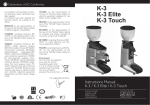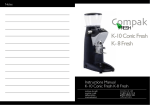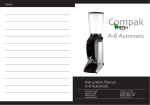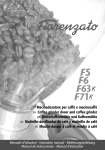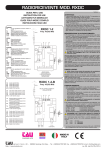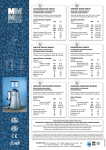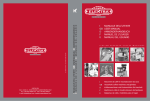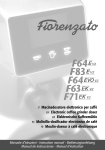Download Compac K6 Instruction manual
Transcript
12 Declaration of EC Conformity In accordance with European commu-nity directives, quality certificates have been applied. All materials have been adapted and technical reports are available at our offices. 04/108/EC on the approximation of the laws of the Member States relating to electromagnetic compatibility. 98/37/EC amending Directive 89/392/EC on the approximation of the laws of the Member States relating to machinery. REG. 1935/2004 amending Directive 89/109/CE on the approximation of the laws of the Member States relating to material and objects destinated to make contact with nutritional products. 03/108/EC amending Directive 2002/96/EC on waste electrical and electronic equipment (WEEE). 06/95/EC of 12/12/2006 on the harmonization of the laws of Member States relating to electrical equipment designed for use within certain voltage limits. K-6 K-6 Silenzio K-6 Professional Barista K-8 Silenzio K-10 Conic K-10 Conic WBC 02/96/EC of 27/01/2003 on the approximation of the laws of the Member States on waste electrical and electronic equipment (WEEE). Environment Do not throw the appliance away with the normal household waste; hand it in at an official recycling collection point. By doing this, you will help to preserve the environment. The Legal Representative Instructions Manual K-6 / K-6 Silenzio / K-6 Professional Barista K-8 Silenzio / K-10 Conic / K-10 Conic WBC molinos de café moulins à café kaffeemühlen macinadosatori moinhos de café кофемолки μαδοι αδσησ καε coffee grinders Index 1 - Machine description 1 Description 3 - Identification K-6 / K-6 Sil / K-6 Pro / K-8 Sil 4 - Technical characteristics 6 - Installation 7 - Regulation 8 - Operation 9 - Cleaning Version 12/2008 This coffee grinder has been designed using the latest computer and engineering technology. The result is a high quality product offering exceptional grinding and dispensing capabilities. It has been manufactured using high quality materials (aluminum, steel, etc.) ideal for use with foodstuffs. For optimal operation of the grinder described in this manual, maximum work duty cycles should be: 2 - Instructions manual 5 - External components PROC-CAL/002/03 K-10 Conic / K-10 Conic WBC CYCLE WORK STOP 10 min. 5 min. 3 min. 5 min. 2 Instruction manual 2.1. The purpose of this manual is to provide the necessary information for the correct installation, handling and maintenance of the machine, and to emphasize the precautions that should be taken into consideration by the operator.To ensure the best use of the coffee grinder, it is essential to carefully follow the instructions included in this manual. In the event of a problem, please contact your local technical service. 10 - Maintenance The manual should be kept until the machine is changed and should always be available to the operator. 11 - Safety measures 2.2. Different terms are used in the manual, such as: 12 - EC Conformity – Characters in bold type, to emphasize importance. – Numbers in brackets following a word, to indicate the position of the item shown in the adjoining drawing or external components diagram. Example:(1) Hopper lid. - Icons (information,warning) information warning i ! 3 Identification The following information is printed indelibly on the technical features plate: i *NOTE: The manufacturer is not responsible for any damage caused to people, objects or the machine itself that results from improper use or failure to comply with the safety guidelines described in this manual. MODEL ELECTRICAL DATA SERIAL NUMBER DATE OF MANUFACTURE OPTIONS TEL. FAX: i NOTE: The manufacturer reserves the right to modify the components of the machine according to the requirements of specific markets or due to the results of technological advances. K-6 / K-6 Sil K-6 Pro MODEL P in / P out P in / P out P in / P out P in / P out 110 v 60 hz 200w/100w 1100 rpm 200w/100w 1100 rpm 280w/150w 1030 rpm 680w/370w 680w/370w 265 rpm 265 rpm 220 v 60 hz 470w/245w 1540 rpm 470w/245w 1540 rpm 470w/245w 1540 rpm 760w/370w 760w/370w 270 rpm 270 rpm 230 v 50 hz 440w/245w 1300 rpm 440w/245w 1300 rpm 380w/200w 1300 rpm 730w/450w 730w/450w 340 rpm 340 rpm 240 v 50 hz 260w/120w 1400 rpm 260w/120w 1400 rpm 245w/140w 870 rpm 730w/450w 730w/450w 340 rpm 340 rpm 380 v 50 hz 400w/245w 1390 rpm 400w/245w 1390 rpm 420w/250w 920 rpm 490w/300w 490w/300w 340 rpm 340 rpm 2.5 / 64 2.5 / 64 24.2 / 11 24.2 / 11 Burrs (in / mm) Production (lb/h Kg/h)* 4 Technical characteristics Hopper capacity (lb / gr) Ground coffee capacity (lb / gr) 4.1. Scope of application The coffee grinders are intended for use on commercial premises and facilities where ground coffee is required, or in small stores that sell coffee. The grinder must only be used to grind coffee beans. Any use other than this will be considered improper and dangerous. Height x width x depth (in / mm) 31.9 / 14.5 P in / P out 3.3 / 83 2.7 / 68 2.7 / 68 33 / 15 37.4 / 17 37.4 / 17 37.5 / 17 37.5 / 17 3.74 / 1.700 0.66 / 300 Lever position Net weight (lb / kg) K-8 Silenzio K-10 Conic K-10 WBC Right 31.9 / 14.5 33.4 / 15.2 25 x 8.2 x 14.4 in 635 x 210 x 365 mm *Production is based on a medium-roasted coffee and an espresso grind. 5 External components 6 Installation i Hopper lid 1 6.1. General warnings The installer should read this instruction manual carefully before installing the machine. The machine must be installed by qualified, authorized staff, respecting the applicable safety and hygiene guidelines. Coffee bean hopper 2 Hand protector 3 Hopper shutter 4 Grind regulator 6 5 Setting roller Position 7 indicator & safety block Dispenser lid 8 Dispenser regulator 9 Tamper 12 Support crutch 13 Ground 10 coffee dispenser Dispenser 11 handle On-Off 14 Switch Coffee collection tray 15 * The K-10 WBC and K-6 Professional models come with a special competition doser and do not incorporate the built-in tamper. ! 6.2. Important warnings The operator must be a responsible adult and under no circumstances a minor or a person unable to deal with said responsibility. When handling the grinder, the following precautions must be taken into consideration: • Do not handle with bare feet • Hands or feet must not be wet • Do not submerge the machine in water • Do not expose the machine to sunlight or other atmospheric conditions • Never insert any object into the coffee input or output openings when the machine is turned on. (Please bear in mind that when the grinder stops, the burrs continue to turn for a few seconds.) • To disconnect the grinder, always pull out the plug and never the electrical cable, to avoid the possibility of a short circuit. 7 Regulation i 6.3. Putting the grinder into place The grinder should be installed on a smooth flat surface. In order to guarantee the optimum performance of the appliance, the minimum dimensions of the work place should be as follows: Height (in / mm.) Width (in / mm.) K-6 / K-6 Sil / K-6 Pro / K-8 Sil K-10 Conic K-10 Conic WBC 31.5 / 800 12.1 / 310 7.1. Preparing the coffee grinder Place the hopper (2) on the grind regulator (6) and check that the shutter (4) is closed, as in Fig 1. Depth (in / mm.) 16 / 400 i 6.4. Installation of the coffee grinder Before connecting the coffee grinder, check the following: Fig. 1 Anchor the hopper by threading the hopper safety screw with help of a flat-head screwdriver and finally adjusting the setting roller (5) by hand. Fig. 2. • That the data on the features label coincides with those of the power supply. • That the electrical current is appropriate for the machine. • That the connection point to the power supply network is protected with appropriate fuses. • That the equipment is properly connected to a grounded socket in accordance with the applicable safety guidelines. i *The coffee grinder should be used in areas with a room temperature below 25/30ºC ( 77/86ºF ) and should not be installed in places (SUCH AS INDUSTRIAL KITCHENS) where cleaning with water jets is used. Fig. 2 Remove the hopper lid (1), fill the hopper (2) with coffee and replace hopper lid. Fig. 3. For security reasons, the regulator (6) is limited to a single turn. Coffee beans Anchored OpenClosed In the Stepped models, the grinding positions are set by the placement of the holes shown in Fig. 5. Using these holes, select the grind point you desire. Free Fig. 3 Connect the machine to the power supply, press the On-Off switch (14) and open the shutter (4) to let the coffee through. Remove the dispenser lid (8) and turn the grind regulator (6) to the required grind setting. By turning it clockwise, the coffee grind will be coarser and turning it counter-clockwise, the grind will be finer. Note that you should only change grind settings when the machine is on and burrs are in motion. If you do not do this, the burrs will gunk up and cleaning will be required. Changing grind settings when the burrs are not in motion will cause the grinder to only make very coarse grinds or no grinds at all. Fig. 4. Fig. 5 i Fine Coarse Fig. 4 NOTE: If the coffee comes out slowly, this is because the coffee is set to grind very fine. If it comes out very fast, it is because the grind is very thick. A perfect espresso is achieved with a grinding point of 25 ml of coffee brewed in 25 seconds. 8 Operation 7.2. Regulating the coffee servings The dispensers are factory adjusted to serve an amount of approximately 7 g. of ground coffee, but this quantity can be regulated between 6 and 10 g, as follows: Remove the ground coffee dispenser lid (8) and turn the dispensing regulation screw (9) clockwise to obtain a smaller amount of coffee, and counterclockwise to obtain a larger amount. Once the quantity of each serving has been regulated, replace the ground coffee dispenser lid (8). Fig. 6. 8.1. Use To turn the machine on and off use the On-Off switch (14). The machine will start to grind the coffee. If the automatic stop option is incorporated, the grinder will stop grinding when the dispenser reaches the maximum level, and will restart after 8 portions of coffee have been served, grinding again to the maximum level. If the machine does not incorporate the automatic stop option, we recommend that you fill the doser 75% of its capacity in order to guarantee consistent dosing. To serve the coffee servings, place the portafilter on the support crutch (13) as far in as possible so that it is positioned under the ground coffee discharge tube. Fig.1. Pull the dispensing handle (11) to obtain one coffee serving (one serving is equal to one cup of coffee), and release it so it returns to its normal position. Fig. 7. Less More Fig. 6 Fig. 7 Take the portafilter and place it under the coffee tamper (12), pressing upwards to pack the coffee. Fig. 8. 9 Cleaning 9.1. General cleaning To guarantee the correct operation of the machine as well as the quality of the ground coffee, we should periodically clean the parts that come into contact with the coffee (at least once a week). Before performing any type of maintenance work, the following indications must be taken into consideration: • Always turn off the machine using the On-Off switch (14). • Disconnect the machine from the power supply. • Do not submerge the machine in water. Fig. 8 When using the telescopic coffee press option, place the portafilter on the crutch and push the coffee tamper downwards. Fig. 9. When using the WBC or K-6 Professional models, we recommend the use of a manual tamper. We recommend the use of cleaning tablet at the end of each day to remove excess grounds 9.2. Cleaning of the coffee bean hopper Before cleaning, make sure that there are no beans left in the hopper (2). Loosen by hand the setting roller (5) and, with the help of a flathead screwdriver, unthread the hopper safety screw. Remove the coffee bean hopper (2) from the grind regulator (6) as in Fig. 2 and clean it with a damp cloth or soap and water to eliminate the oil residues from the coffee, washing it carefully and then drying. Put the hopper back on the grind regulator and thread the hopper safety screw with the help of a flat-head screwdriver and adjust the setting roller (5) by hand. 9.3. Cleaning the ground coffee deposit To clean the ground coffee holder, first empty all the coffee inside it. Remove the ground coffee dispenser lid (8) and clean the inside, using a small brush. Fig. 9 9.4. Exterior cleaning To clean the exterior, use a brush or a cloth dampened with a little bit of soap and water. NOTE: Never use damp clothes to clean the coffee deposit. Conserve the brush in a protected place and only use it to clean the grinder to avoid it being contaminated from other substances. Not following these instructions could affect the taste and aroma of the coffee. 10 Maintenance i 10.1. General warnings Before performing any type of maintenance work, the following indications should be taken into consideration: • Always turn off the machine using the On-Off switch (14). • Disconnect the machine from the power supply. In the event of a breakdown or malfunction, turn the machine off. Do not try to repair it or intervene directly. Please call your local technical service. NOTE: Failure to respect this warning could endanger the safety of both the machine and user. 10.2. Regular maintenance To guarantee the efficiency and correct operation of the grinder, it is essential to follow manufacturer instructions and ensure that all maintenance work is carried out by qualified staff. Regular, programmed inspections are recommended of the parts subject to wear and tear. Systematically check the usage level of the burrs. The perfect condition of the burrs guarantees an even grind of the coffee and optimum quality of the product served. It also reduces electrical consumption and the risk of the motor and burrs overheating. NOTE: Based on extensive experience and a medium-hard coffee blend, we recommend replacing the burrs after grinding 300 Kg/660 Lb of coffee with the K-6 & K-8 models and 1500 Kg/3300 Lb with the conical models. 10.3. Grinding group maintenance For grinding group maintenance, follow these instructions: Turn off the machine using the On-Off switch (14). Disconnect the machine from the power supply. Loosen the setting roller (5), as shown in Fig. 2, and remove the hopper (2) from the grind regulator (6). Release the 3 screws on the grind regulator (6) using an Allen key as shown in Fig. 10. # # # Fig. 10 Turn the grind regulator (6) clockwise, until it lifts off. Using a small brush or vacuum, clean the inside of the grinding chamber. Check the condition of the burrs and change them, if necessary. If not, 11 Safety measures put the regulator back in place, turning it counter-clockwise as in Fig. 11 until the burrs touch and replace the 3 screws. Unthreading direction Threading direction NOTE: The manufacturer cannot accept responsibility for any damage caused by improper use of the machine or failure to respect the safety measures indicated below. Users are asked to pay careful attention to the following indications: Additional safety elements incorpated into our grinder models: • Hand protector located in the doser in order to avoid fingers accidentally getting caught in the grinding burrs • Special fixing screw to hold the hopper in place i Fig. 11 10.4. Accessing the burrs Follow the instructions in 10.3. in order to remove the grind regulator, removing the 3 screws as explained in Fig. 10. Once this is done, you will have to manually turn the upper burr holder clockwise to remove it from its housing as in Fig. 12 Fig. 12 After changing the burrs, assemble the upper burr holder by threading it counter-clockwise, replace the grind regulator (6) and follow the instructions as shown in Fig. 10 & 11. • The coffee grinder should only be used for grinding coffee beans. • Do not use the machine to grind other types of foods such as nuts, dried fruits or to fine-grind granulated foods such as sugar, etc. • Do not allow minors or disabled people to use the machine. ! • Any other use of the machine will be considered improper and dangerous. • Do not allow liquids to come into contact with the internal or external surfaces of the machine at any time, except for those parts that have been expressly referred to in the “CLEANING” section. If, for any reason, this should occur, immediately disconnect the machine from the power supply and dry all surfaces carefully. Should it be necessary to access the internal parts of the machine, where the electrical components are located, take the machine to your local technical service. • In the event of any broken components or intervention, we recommend that you contact your local technical service, who will repair or replace the part, guaranteeing the maintenance of the safety standards. • Replacement of the main power cable of any grinder model should only be done by an authorized supplier.










